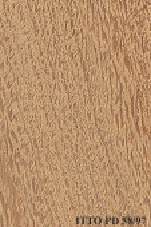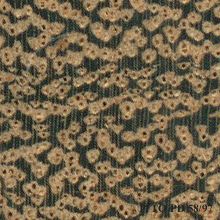
ANGELIM (Hymenolobium modestum)
Trade Name
Angelim
Scientific Name
Hymenolobium modestum Ducke
Family
LEGUMINOSAE
Common Names
Alcornoco; Angelim-Pedra (Brazil); Angelim (Brazil)
Description Of The Tree
Botanical Description
The commercial lengths are reported to average 6 to 7 m, with diameters from 45 to 55 cm. The logs are reported to be straight and cylindrical, with low buttresses.
Natural Habitat
Hymenolobium modestum is a dominant tree found in the canopy of terra firme tropical rain forests of northern South America. It is reported to prefer dry areas.
Natural Distribution
The natural distribution range of this genus is the Amazon basin and northern South America.
Non Timber Uses
Fairly often oily or waxen patches can be observed.
Wood Identification
Anatomic Description Of Wood
Wood diffuse porous. Vessels exclusively solitary (over 90%). Tangential diameter of vessel lumina 200 micras or more (large). Resinous deposits in heartwood vessels. Vestured pits. Vessels per mm2 6 to 10 (medium). Simple perforation plates. Vessel-ray pits sim Axial parenchyma in marginal or in seemingly marginal bands. Axial parenchyma aliform. Axial parenchyma confluent. Axial parenchyma confluent unilateral paratracheal. Prismatic crystals in non-chambered axial parenchyma cells. Prismatic crystals in chambered a 4 to 10 rays per mm (medium). Rays storied. Rays 1 to 4 seriate. Body ray cells procumbent with one row of upright and/or square marginal cells (Kribs-III). Fibers very thin walled. Fibers with simple to minutely bordered pits.
-
 Wood Macro Photo Tangential Plane
Wood Macro Photo Tangential Plane
-
 Wood Micro Photo Of Transversal Section
Wood Micro Photo Of Transversal Section
Availability
Cites Status
Unrestricted
General Wood Description
Odor
It has no discernible odor or taste.
Color
The sapwood is pink color, the heartwood is reddish yellow with lighter color stripes.
COLOR INDEX (1=Black, 7=Light yellow,white)
5
Grain
Interlocked grain is reported in this species.
Texture
The wood is mostly coarse in texture.
Luster
Timber of this species is low in luster.
Natural Durability
It is resistant against fungi and dry wood insects, but it is rated as moderately resistant against marine borers.
Natural durability index (1= Very high durability, 7=Vey low durability)
4
Resistance To Impregnation
The sapwood is easy to preserve with water soluble products, the heartwood is untreatable.
Wood Physical Properties
Basic Density or Specific Gravity (O.D. weight/vol. green) (g/cm³)
0.68
Air-dry Density (Weight and volume at 12%MC) (g/cm³)
0.76
Total shrinkage Tangential (Saturated to 0%MC) (%)
7.5
Total shrinkage Radial (Saturated to 0%MC) (%)
4.6
Recommended Dry Kiln Schedule
BR-A
Dimensional stability ratio (Total Tangential Shrinkage %/Total Radial Shrinkage %)
1.6
Wood Chemical Properties
Wood Mechanical Properties
Bending Strength (MOR),12%MC (kgf/cm²)
1072
Stiffness (MOE) 12%MC (kgf/cm²)
146822
Compression parallel to fiber 12%MC (kgf/cm²)
640
Compression perpendicular to fiber 12%MC (kgf/cm²)
107
Shear strength radial 12%MC (kgf/cm²)
119
Janka hardness (side) 12%MC (kgf)
704
Janka hardness (end grain) 12%MC (kgf)
783
Workability
Sawing
Cutting behavior is reported to be fair to difficult.
Rotary Veneer Cutting
This species is reported to be interesting for decorative veneer.
Sliced Veneer
This species is reported to be interesting for decorative veneer.
Blunting Effect
The blunting effect is rated as negligible.
Planing
Planning operations are reported to be easy, but with very bad finishing. Torn and fuzzy surfaces may occur.
Boring
Boring is easy but with bad finishing.
Nailing
Hymenolobium has a good holding of nails, but risks of split on end grain are reported.
Gluing
Gluing of this species is easy.
Sanding
Sanding is easy but with bad finishing, fuzzy surfaces are reported.
Response To Hand Tools
It is difficult to cut.
REFERENCED USES
End Uses Summary
HOUSING GENERAL, FURNITURE AND CABINETS
General Housing
- 10 - Silica in Timbers
Furniture Cabinets
- 21 - Tropical timbers of the world. Part III-Southeast Asian and Oceanian Species.
Please Provide Information To View Producer Information